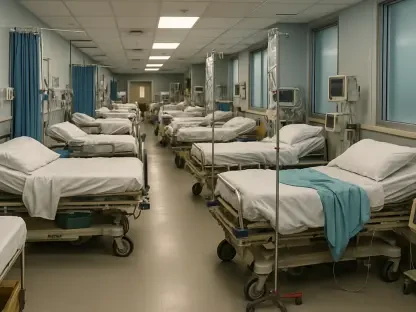Imagine a cornerstone of American public health teetering on the edge of collapse, shaken by violence at its headquarters and threatened by massive budget cuts, leaving many to wonder about the future of disease prevention in the nation. The Centers for Disease Control and Prevention (CDC), an agency tasked with safeguarding millions from disease, faces unprecedented turmoil. A tragic shooting at its Atlanta campus, combined with proposed funding slashes and political restructuring, has sparked alarm among experts, employees, and advocates. This roundup delves into diverse opinions and insights from multiple sources to uncover how these crises impact the CDC’s mission, from workplace safety to critical programs like HIV prevention. The purpose is to illuminate varying perspectives on the challenges and explore potential paths forward for an agency at a critical juncture.
Unpacking the Chaos: Diverse Views on the CDC’s Struggles
Workplace TraumReactions to the Atlanta Shooting
The shooting incident at the CDC’s Atlanta headquarters on August 8 has left a deep scar on the agency’s workforce, with many grappling with fear and uncertainty. Insights gathered from anonymous employee accounts reveal a pervasive sense of vulnerability. Several workers have expressed hesitation about returning to a workplace where violence shattered their sense of security, highlighting a pressing need for enhanced safety protocols. Reports suggest that the incident, which claimed the life of a police officer, has intensified existing stress among staff already facing professional instability.
Public health professionals outside the agency have weighed in, emphasizing the psychological toll of such an event. Many argue that the trauma could lead to a significant loss of talent, as some employees consider early retirement or alternative careers. This perspective underscores the urgency of providing mental health support and clear communication to rebuild trust. The consensus points to a broader concern: without addressing workplace safety, the CDC risks further erosion of morale at a time when focus is desperately needed.
A contrasting viewpoint from organizational safety experts suggests that while the incident is tragic, it should not overshadow systemic issues within the agency. They advocate for a balanced approach, urging leadership to integrate robust security measures without diverting resources from core public health missions. This opinion highlights the complexity of managing immediate crises while maintaining long-term goals, painting a nuanced picture of the challenges ahead.
Budget Cuts: Opinions on Funding Threats to HIV Prevention
Proposed budget reductions, slashing CDC funding from $9.2 billion to $4.2 billion, have sparked fierce debate among public health stakeholders. Advocacy groups focused on HIV prevention express alarm over the potential dismantling of key initiatives like the Ending the HIV Epidemic (EHE) program. They warn that losing tools such as the Medical Monitoring Project and home testing kits, which have reached hundreds of thousands, could reverse decades of progress in curbing infection rates. Their stance is rooted in data showing the real-world impact of these programs on vulnerable populations.
State health officials offer a different angle, pointing to the cascading effects of federal cuts on local efforts. Many note that without CDC support, regional programs in high-risk areas like Georgia could collapse, leading to gaps in testing and treatment access. This perspective emphasizes the interconnectedness of national and local health systems, suggesting that federal disinvestment might create a domino effect of health disparities across the country.
On the other hand, some fiscal policy analysts argue that budget constraints are a necessary reality in a broader push for government efficiency. They contend that the CDC must adapt by prioritizing high-impact areas and seeking alternative funding sources, such as private partnerships. While acknowledging the risks to programs like HIV prevention, this viewpoint challenges the assumption that federal funding is the only solution, sparking a debate on sustainability versus immediate need.
Political Restructuring: Debating the Shift to a New Division
The proposed overhaul to move CDC functions into a new Department of Health and Human Services (HHS) division, dubbed the Administration for a Healthy America (AHA), has drawn mixed reactions. Public health advocates voice skepticism, citing a lack of transparency about how this shift would preserve the agency’s core capabilities. Many fear that restructuring could dilute focus on critical issues, especially in states with urgent needs, and question whether the administration prioritizes public health amid competing political agendas.
Legislative observers provide a more hopeful outlook, pointing to Senate efforts to maintain CDC funding at around $9 billion. They argue that congressional resistance could serve as a buffer against drastic changes, potentially preserving essential programs if advocacy remains strong. This perspective highlights the role of political will in shaping health outcomes, suggesting that sustained pressure from lawmakers and constituents might influence final decisions.
Conversely, some policy reform proponents see the restructuring as an opportunity to modernize an agency they view as overburdened. They suggest that a new framework under HHS could streamline operations, provided clear guidelines and accountability measures are in place. This opinion, while optimistic, acknowledges the uncertainty surrounding implementation, reflecting a divide between those who fear change and those who see potential for improvement.
Community Impact: Concerns for Vulnerable Populations
The potential rollback of CDC programs has raised significant concern for marginalized groups, with community leaders sounding the alarm on health equity. Many emphasize that communities of color, LGBTQ+ individuals, and those facing economic barriers would bear the brunt of reduced access to prevention and treatment services. They argue that federal support is indispensable for addressing systemic disparities, particularly in regions with high disease prevalence.
Local health department representatives echo this sentiment, citing examples of staff layoffs and program cuts in areas like Los Angeles County as evidence of broader fallout. Their insights reveal a stark reality: without federal backing, state and county systems struggle to fill the gaps, risking spikes in preventable diseases. This viewpoint underscores the critical role of the CDC as a stabilizing force in national health infrastructure.
A differing take from some health economists suggests that while the impact on vulnerable groups is undeniable, solutions could lie in targeted interventions rather than blanket funding. They propose reallocating limited resources to high-need areas while encouraging community-based organizations to step in. This pragmatic approach, though controversial, aims to balance fiscal constraints with social responsibility, adding another layer to the ongoing discussion.
Key Takeaways: Lessons from the CDC’s Challenges
Reflecting on the multifaceted crisis at the CDC, several key insights emerged from the diverse perspectives shared. The emotional and psychological impact of the Atlanta shooting revealed a deep need for workplace safety and support, as employees grappled with trauma amid professional uncertainty. Budget cuts threatening HIV prevention programs sparked widespread concern among advocates and state officials, though some policy analysts pushed for innovative funding models. Political restructuring divided opinions, with fears of diminished focus countered by hopes for modernization, while the potential harm to vulnerable communities united many in calling for sustained federal investment. These discussions painted a complex picture of an agency under strain, yet highlighted actionable paths forward, such as bolstering congressional advocacy, enhancing security measures, and exploring localized solutions. For those eager to dive deeper, exploring reports from public health advocacy groups and legislative updates on funding battles offers valuable context and next steps to support the CDC’s mission.









